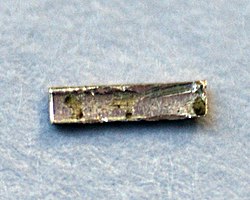Radium
Radium, in the form of radium chloride, was discovered by Marie Skłodowska-Curie and Pierre Curie in 1898. They extracted the radium compound from uraninite and published the discovery at the French Academy of Sciences five days later. Radium was isolated in its metallic state by Marie Curie and André-Louis Debierne through the electrolysis of radium chloride in 1910. Since its discovery, it has given names like radium A and radium C2 to several isotopes of other elements that are decay products of radium-226.
In nature, radium is found in uranium ores in trace amounts as small as a seventh of a gram per ton of uraninite. Radium is not necessary for living organisms, and adverse health effects are likely when it is incorporated into biochemical processes because of its radioactivity and chemical reactivity.
Occurrence
All radium occurring today is produced by the decay of heavier elements, being present in decay chains. Owing to such short half-lives of its isotopes, radium is not primordial but trace. It cannot occur in large quantities due both to the fact that isotopes of radium have short half-lives and that parent nuclides have very long ones. Radium is found in tiny quantities in the uranium ore uraninite and various other uranium minerals, and in even tinier quantities in thorium minerals.
Radium-226 is a decay product of uranium and is therefore found in all uranium-bearing ores. (One ton of pitchblende typically yields about one seventh of a gram of radium).
| Symbol | Ra | |
| Atomic Number | 88 | |
| Atomic Weight | 226.0254 | |
| Oxidation States | +2 | |
| Electronegativity, Pauling | 1.1 | |
| State at RT | Solid, Metal | |
| Melting Point, K | 973 | |
| Boiling Point, K | 1413 |
Appearance and Characteristics
Harmful effects:
Radium is highly radioactive and hence carcinogenic. Microscopic quantities of radium in the environment can lead to some accumulation of radium in bone tissue. Radium, like calcium, is a group II element and our bodies treat it in a similar way.
Characteristics:
- Radium is a silvery-white metal. It is highly radioactive and its decay product, radon gas, is also radioactive. One result of radium’s intense radioactivity is that the metal and its compounds glow in the dark.
- When it is exposed to air, it reacts with nitrogen to quickly form a black coating of radium nitride.
- Radium’s chemistry is similar to that of the other alkali earth metals. It reacts very vigorously with water to form hydrogen gas and radium hydroxide. It reacts with even more vigorously with hydrochloric acid to form radium chloride.
Uses of Radium
- Radium was used in the production of luminous paints, but this is now considered too dangerous.
- Radium chloride was used medicinally to produce radon gas for cancer treatment. Safer treatments are now available.
